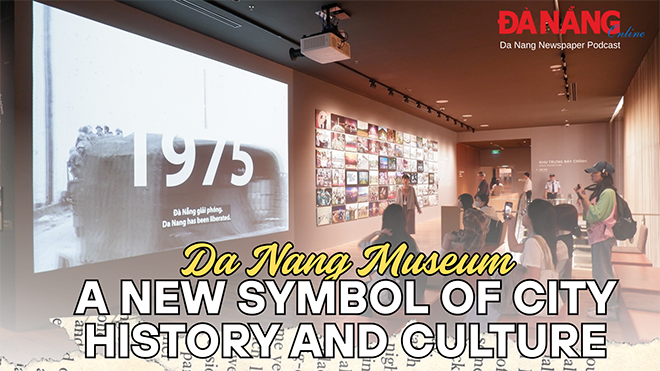Forest rice, heaven's liquor
The 2024 Co Tu Cultural and Sports Festival at the Guol house in Gian Bi Village, Hoa Bac Commune, Hoa Vang District, Da Nang was lively with activities from the residents of Ta Lang and Gian Bi villages, along with tourists. In addition to enjoying traditional Co Tu singing and collective games like tug of war, sack bag jumping, and stilt walking, visitors were introduced to signature Co Tu dishes such as stone snails, bamboo-tube rice, grilled meat, and taro frog soup.
At the festival, the food was meticulously prepared and beautifully presented. Ms. Tran Thi Mot, from Gian Bi Village, shared that" Today's meal is the collective effort of the villagers. Everyone contributed from early morning, whether catching snails, fish, or starting the fire. Festivals like these are opportunities for us, especially the younger generation, to preserve and promote the unique cultural values of the Co Tu people to visitors."
 |
| Co Tu cuisine has become a tourism product. Photo: X.S |
Forest Rice
According to the Hoa Vang District's Department of Culture and Information, traditional Co Tu cooking methods are similar to those of other mountain communities along the Truong Sơn range. For instance, bamboo-tube rice is made by filling bamboo tubes with glutinous rice and water, sealing them with leaves, and roasting them over a fire. The Co Tu typically cook once in the morning, saving the food for the entire day. This method is also used for cooking meat and fish.
"The bamboo-tube cooking method imparts a unique flavor but is mostly reserved for forest trips, special dishes, or rituals. On regular days, Co Tu people use clay or copper pots," said Mr. Do Thanh Tan, Head of the Hoa Vang District's Department of Culture and Information.
The Co Tu are skilled in cooking, with nearly a dozen ways to prepare pork alone. Their sauces are also crafted with care, typically made from finely ground raw salt mixed with forest chili and pepper, sometimes with added special kind of vegetable or green beans for a unique flavour. Apart from main spices like chili, lemongrass, and forest pepper, the Co Tu also use red ants and termites to enhance the taste. In times when salt was scarce, they would burn thatch to obtain ash as a substitute. Food is often dried and stored above the kitchen for later use.
Heaven's Liquor
During our trips to mountain areas such as Hoa Bac and Hoa Phu communes in Hoa Vang District, Da Nang, and Dong Giang and Tay Giang districts in Quang Nam Province, we enjoyed many mountain liquor varieties with the Co Tu people. Among them, the most popular is Co Tu rice wine (buôh), along with tà vạt wine (from the đoát tree), tr’đin wine (from the đủng đình tree), and mây voi wine. These liquors, embodying the essence of the earth, sky, and forest, are essential at gatherings, festivals, and celebrations.
Mr. Le Van Nghia, Party Secretary and Head of Phu Tuc Village in Hoa Phu Commune, has been preserving the tradition of making Phu Tuc rice wine for many years. This wine is brewed from glutinous rice with husks or from corn, cassava, and sweet potatoes. The yeast is made from a blend of secret forest leaves. The wine is aged in ceramic jars (zóq), which are prized possessions of the Co Tu people, and the longer it is aged, the better it tastes. To drink, fresh spring water is poured into the jar, bamboo straws are inserted, and the wine is sipped. This rice wine has a sour-sweet taste and is often reserved for special occasions.
Behind the rice wine jars is a story of Co Tu beliefs, which Mr. Do Thanh Tan has studied extensively. For instance, while making the wine, from cooking the rice to placing it in the jar, women and those in mourning are traditionally prohibited from entering the area. The Co Tu also erect a p’hok tree to 'cover the mouth,' a reminder to others not to speak ill, as it is believed this could bring misfortune to the wine batch.
Eight summers ago, during a field trip to Atiêng Commune, Tay Giang District, we had the opportunity to savour the sweet, golden "heavenly wine" extracted from the tr'din tree. This special wine is made from the sap of the rare tr'din tree. The process of extracting wine from trees like tà vạt, tr'din, or rattan is complex and requires significant expertise, with the most challenging being rattan due to its thorny nature. The wine is mixed with “chuồn” bark to create carbonation and increase potency, but without it, the wine remains sweet and has a low alcohol content.
Years later, Mr Dinh Van Hin, the Head of the village, discuss the cultivation of native tr'din and tà vạt trees along the Cu De River. If these plantations thrive, the people of Hoa Bac could have an additional livelihood and unique culinary products. At the 2024 Co Tu Cultural and Sports Festival, tà vạt wine was served, with the wine being extracted from the very trees in Hoa Bac's forests for the guests.
Preservation and promotion
According to Mr. Do Thanh Tan, the preservation and promotion of the Co Tu community's cultural values in Da Nang have been prioritised by the city and Hoa Vang District for many years. The district has collaborated with the Tourism Promotion Centre and media outlets to spread the image of Co Tu culture, focusing particularly on its cuisine. Another positive development is the preservation of the “niên fish”, which had seen a decline due to various factors. Thanks to the collaboration between local authorities and community groups, the fish population has increased in the upper Cu De rivers and streams.
The Co Tu people, who play a direct role in shaping the tourism landscape based on their ethnic heritage, are gradually becoming more professional as tour guides, chefs, and receptionists. Since 2023, the district has trained them to enhance their skills in community-based tourism.
"Using traditional ingredients and familiar Co Tu dishes, the quality and presentation have been improved through training from the Department of Tourism to meet modern standards. The dishes are now presented beautifully and meet the requirements for serving tourists. This is a strength of community-based tourism when the villagers work together," Mr. Tan emphasised.
Elder Bui Van Sieng, born in 1950, from Gian Bi village, expressed joy that the cultural identity of the Co Tu people is being preserved and embraced by tourists. In this cultural flow, their cuisine remains a lasting tradition, passed down through generations.
Reporting by Xuan Son - Translating by TRUC VY








